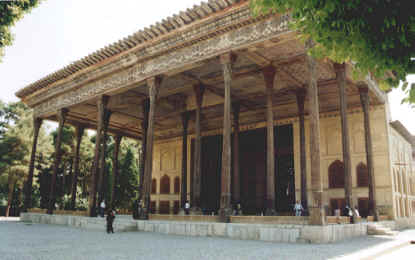|
|
Isfahan is one of the most attractive ancient cities in Iran. It entered upon its golden age in 1598, when Shah Abbas I, the famous Safavid King, chose it as the center of his government. He redesigned the city and endowed it with many exquisite buildings, including mosques, palaces and pavilions. One of these buildings is called "Chehel Sotun Palace" (means: 40 Columns Palace).
Chehel Sotun Palace is striking example of Safavid king's court. It is, in fact, magnificent pavilion, built in the middle of a garden covering 67,000 Sq. m, as the far end of long rectangle shaped pool.
Chehel Sotun Palace is actually supported by 20 tall wooden columns. Each of the columns is made of single tree trunk in the front porch. These columns are reflected in the still water of the pool in front of the building and altogether display 40 columns. This is why this pavilion is called Chehel Sotun Palace.
It is believed that the construction of this palace started during the reign of Shah Abbas I and was completed during the reign of Shah Abbas II. It was inaugurated i 1646 at the presence of Shah Abbas II and foreign ambassadors. The palace was used for state occasions. Safavid kings received their dignitaries and ambassadors, here.
Among historical monuments of Safavid era, Chehel Sotun Palace is famous as a veranda and throne room of Shah Abbas. It has one terrace, overlooking the pool and various state reception halls.
Forty-column building was erected in compliance with the traditional architecture, i.e. with arches and openings of objectivity. Small rooms around original hall, along with Eastern and Western verandas and Northern and Southern verandas, have surrounded the hall, like strong belt. This building has Eastern and Western symmetrical axis. Geometrical order of its plan and architectural facade give rhythmical and dignified view.
Large and small halls are decorated with huge and attractive paintings, on the wall and ceiling, including senses of Safavid wars against Ottoman, Royal ceremonies and formal receptions.
Wall paintings of the building are superlative in their kind. On the outside are paintings of foreign emissaries, who visited Safavid court as well. Magnificent miniatures on walls and ceilings are among this colorful and elegant treasure.
Small paintings show senses with the style of miniature of Isfahan school. Around the building, particularly in Northern and Southern verandas, exist architectural ornaments with mural paintings, in which the influence of Western and European tastes are apparent. Chehel Sotun is regarded new era in Iranian architectural ornaments.
Harmonious and charming architecture of this palace is decorated with:
- water color and oil murals in Iranian and European styles
- painting on wood
- painting on marble cornices
- plinths in the form of curtains
- stucco-work
- border work
- gilding at large scale on wall and ceiling
In 1706, Chehel Sotun got in fire. It is restored during past centuries.

|
|

